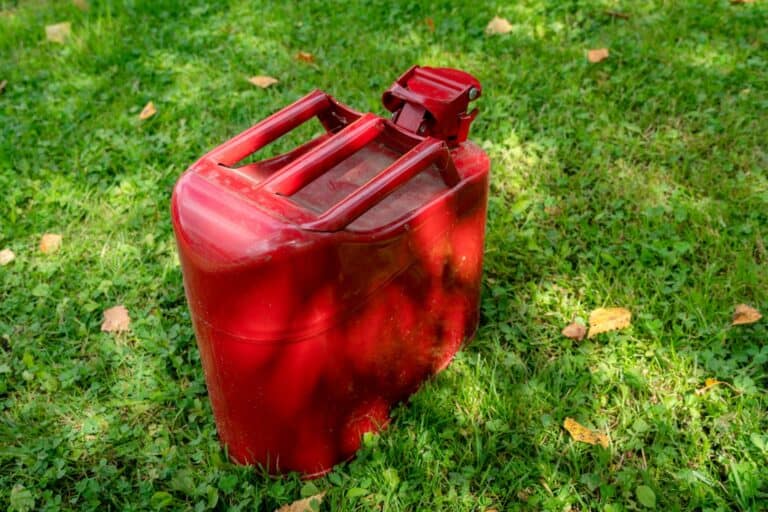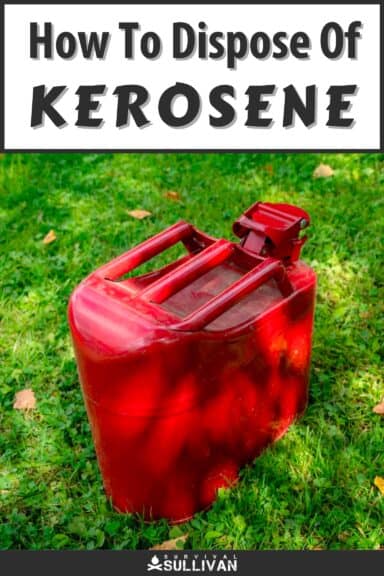Kerosene is one of the best fuels when it comes to long shelf life. Depending on the variety and the additives, you can get anywhere from 2 to 6 years out of your kerosene if it’s kept in a proper storage container and in good conditions.

But no matter how diligent you are about rotating your supply, it rarely fails that, every once in a while, you’ll let your kerosene get too old.
Instead of risking damage or malfunction in your heaters or other appliances, it’s best to just get rid of it. But, you should never pour your kerosene out on the ground or down a drain.
There are several easy ways to get rid of old kerosene safely, and I’ll tell you how in this guide.
Manage Your Supply to Minimize Waste and Subsequent Disposal
Keep in mind that the best way to dispose of kerosene is not having to dispose of it in the first place, if you take my drift.
If you consistently wind up with kerosene that you need to get rid of rather than use, this is symptomatic that you either aren’t rotating through your supplies often or regularly enough, or you are just keeping way too much on hand.
It’s good to have reserves, of course: preparation is paramount! However, waste is never good and all that’s doing is costing you money.
Consider buying smaller quantities in the future or else rotating your stash more often so the stuff in storage does not have the opportunity to go bad.
Always Store Kerosene in Durable, Approved Containers!
For all of the methods in the following section, you must remember to always store and transport your kerosene in approved fuel containers!
Using improper containers is going to increase the likelihood of a spill, or the accumulation of flammable vapors which could result in a massive accent, especially if you are going down the road in vehicle.
According to standard practices in the U.S., kerosene fuel containers are typically blue in color, to contrast with the “hazard red” of gasoline containers.
Make sure you don’t confuse these with water!
7 Options for Disposing of Kerosene Safely
You have several good options for disposing of kerosene. I have them presented below, and the general order of least wasteful and least aggravating to the most wasteful or most aggravating.
All of them will work, though, depending on where you live…
1. Mix Stale Kerosene with Fresh to Use it Up
One of my favorite ways to dispose of old kerosene is simply to mix it in, in a small ratio, to good, fresh kerosene so I can simply use it up in my heaters and other appliances as I would normally.
Generally speaking, as long as you keep a ratio of about 75% to 80% good kerosene to bad, you won’t have any issues.
But, as always, you need to know your equipment and what it will and won’t tolerate when it comes to fuel quality.
Another thing, never attempt this method if your old kerosene is truly beyond saving or using: if it is slightly discolored or darker than usual, that won’t be a problem.
But, if you notice your kerosene has a serious mold infestation, is undergoing phasic separation or is obviously contaminated with rust or some other detritus don’t even try it!
2. Donate Surplus to Neighbors or Businesses
Is your kerosene getting old, but it isn’t too far gone?
Ask around in your neighborhood and any local businesses you know that rely on kerosene for any purpose.
Chances are pretty good that somebody could use it and could it quickly put it to work before it truly spoils.
You might be out some money on kerosene, but you’ll be building goodwill and preventing waste.
Again, this is not the time to pawn off any kerosene that is too far gone!
At best, whoever you are trying to pawn it off on will think you are an absolute shyster and rightly so, and at worst you might be damaging or destroying someone else’s property!
Always do the right thing.
3. Drop Off at Car Repair Business or Gas Station
Okay, so if you don’t have a way to blend your old kerosene with your newer stuff, or if it’s just too far gone, then it’s time to get rid of it properly.
One of the most convenient options is to call around to your local automotive service centers and gas stations and see if they accept old fuel.
Many will, but definitely ask them if they accept kerosene. Some of these places will accept old gasoline but they won’t accept kerosene.
If they will, all you need to do is load up the old stuff that’s no good and take it to them. They will do the rest.
Ideally, you’ll be able to dump the kerosene into a collection tank or into temporary containers they have on site but at worst you might be out your containers too.
Ask to be sure so you can sort out the logistics beforehand.
4. Get Rid of Unwanted or Bad Kerosene on Community Collection Day
Most larger towns, pretty much every city and many counties will put on hazardous waste collection days periodically, usually twice a year but sometimes just once a year.
Check your city or county website for details, or call a number you see associated with the event to double-check and be sure they will accept kerosene.
Most accept some truly heinous stuff, so kerosene should be no issue but it still pays to be sure.
The downside to this method is that there might be a fee associated with the drop off generally, perhaps with the quantity of the kerosene you are turning in or with kerosene specifically.
Even so, this is one of the most straightforward and least expensive methods for responsible disposal.
5. Contact Hazardous Waste Disposal Service
If you don’t have a hazardous waste turn-in day in your community or you just can’t wait that long, time to hop on the internet or, gasp, bust out the phone book and look for a hazardous waste disposal service.
These businesses are typically for-profit, and there will be a fee associated with you getting rid of your kerosene, but it’s usually nominal for something that isn’t seriously dangerous like hydrofluoric acid.
The good news is that many of these companies offer a pickup service, so if you have a huge quantity or just don’t want to go through the hassle and risk of transporting the kerosene, chances are they will come to you.
6. Call the Fire Department Non-Emergency Line
Sigh. Your kerosene is too old to risk mixing with the new stuff and you don’t want to be a monster by hoisting it on your neighbors or anyone else.
Your community or county doesn’t have a hazardous waste turn-in day and there’s no such business that handles the stuff in your town, a service center or anywhere else.
What in the world are you supposed to do now?!
Well, you tried everything else that a good citizen is expected to do, so considering that this stuff is a fire hazard you should call the experts when it comes to dealing with such things: your local fire department.
Note: do not call the emergency line for this!
Call the non-emergency line and simply explain the situation and then follow their instructions or advice.
They should be able to help you or at the very least give you guidance on what to do.
7. If All Else Fails, Burn it Off
If you have absolutely no other option, you might not have any other choice except to burn off your old kerosene.
Yes, this is a wasteful and somewhat polluting method, but it’s a whole lot less polluting than pouring it down the drain or straight into the ground like so many people do.
But in the end you still need this kerosene gone and so you might have to burn it.
So, if you’re forced to burn off your kerosene safely without blowing yourself up or burning your house to the ground how should you do it? Here’s what I would do.
- Pour a quantity of kerosene in a small but sturdy metal container like a large pot or a small trash can. Work in small batches to reduce the fire hazard.
- Moving quickly, get a long branch or tape a match to the end of a long handle. Stand well back from the kerosene, and light the end of the branch or the match.
- Standing as far away as you can, carefully ignite the vapors coming off of the kerosene. Note that you should get the kerosene lit as quickly as possible to prevent these vapors from accumulating and spreading out from the container. This is what can cause a dangerous combustion event.
- Let the kerosene burn off. When it is completely gone, allow the container to cool all the way down before you add more kerosene and then repeat the process until your kerosene is gone.
And that is all there is to it. Obviously you want to do this in a place and at a time when it is safe to.
Never do it close to your house or during a burn ban, and make sure you clear the surrounding area of flammable materials and keep a B-class fire extinguisher nearby just in case.
If you want to cut down on smoke, you can do the same process but using a rocket stove.
Rocket stoves burn so hot they will ensure more complete ignition and fewer combustion byproducts which means less black, sooty smoke and less pollution.


Tom Marlowe practically grew up with a gun in his hand, and has held all kinds of jobs in the gun industry: range safety, sales, instruction and consulting, Tom has the experience to help civilian shooters figure out what will work best for them.

not everyone is into outdoor wick lantern & torch lighting for patio and yard entertainment and some security >>> but that part of grid down prepping will utilize almost any low-flammable fuels – kerosene will even work great as a thinning agent to burn waste crankcase oil …..